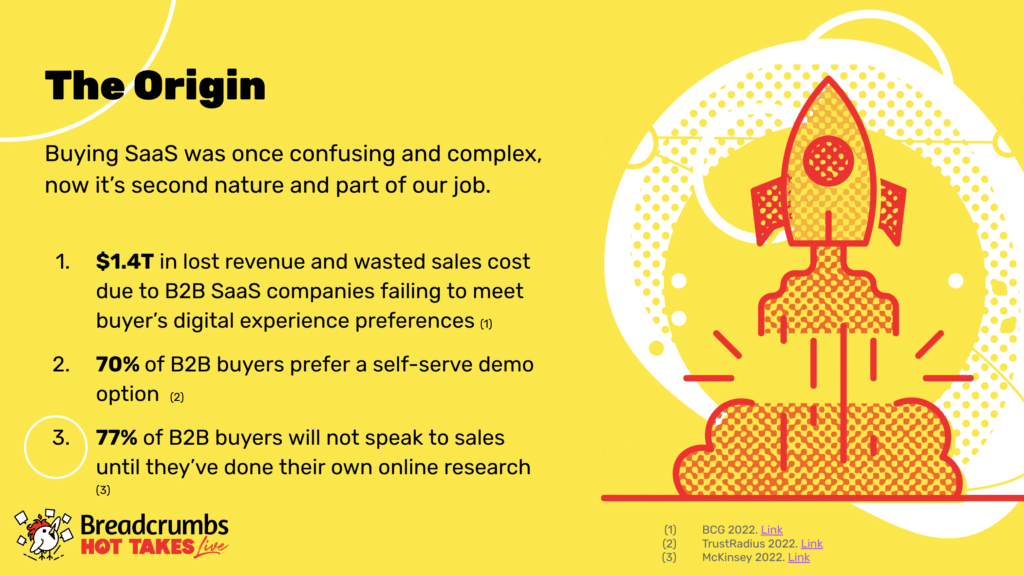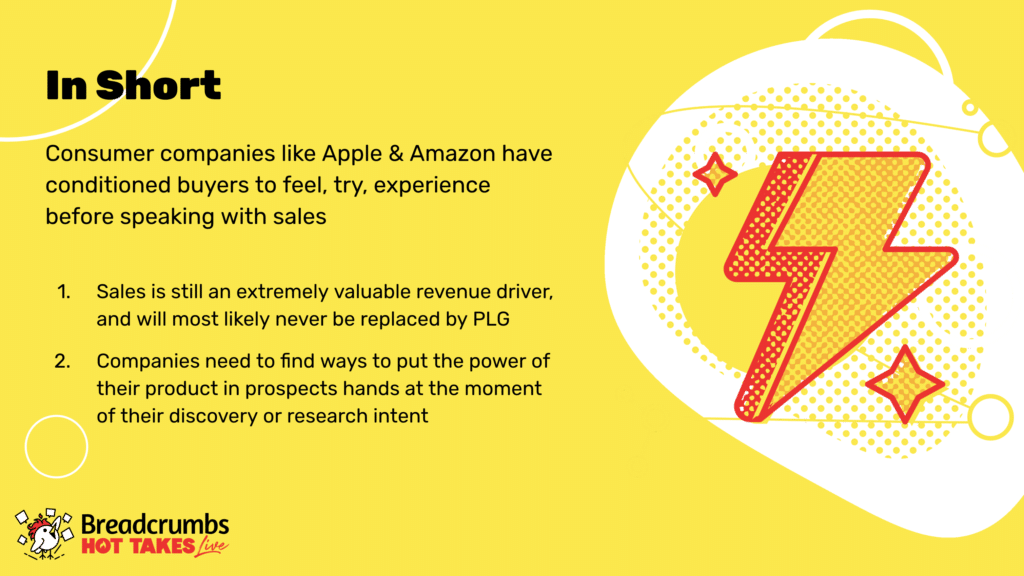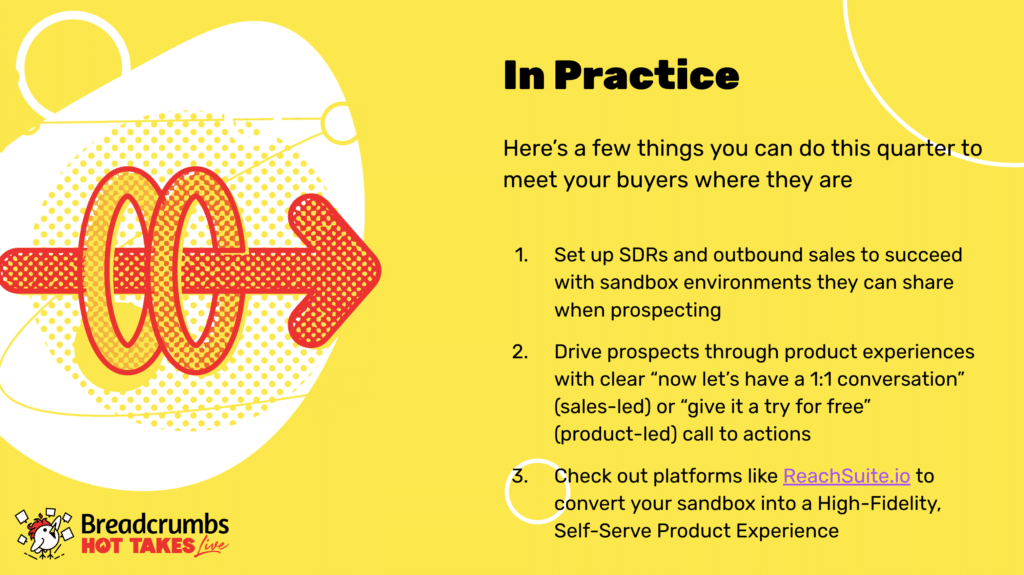70% of B2B buyers demand a self-serve demo. Unfortunately, this stat is intuitive–if you’re a buyer, you’ve never gotten excited over a ‘book a demo’ button. If you’re a seller, you viscerally understand how hard it is to earn 30 minutes on a prospect’s calendar.
In 2023, companies that democratize the value of their platform by enabling anyone, anywhere, to feel the power of their platform on-demand … those companies will win. And those who hide their product behind a ‘book a demo’ button may struggle to get ahead.
In this session with Collin Smith, Head of Commercial Strategy at Viz.ai, you will learn:
- How to win in 2023 with self-serve product experiences
- The importance of building atop of your real product vs. screenshots
- KPIs that will improve when you transition from sales-led only to enabling prospects to experience your product
[Transcript] The ‘Request A Demo’ Button Is About To Die
Joe Aicher
We have our next presenter, Collin Smith, who is Head of Commercial Strategy at Viz.ai. Let’s bring Collin in. How are you doing?
Collin Smith
Good to see everyone! This is my second Hot Take, so it’s happy to be back. The last one was the first one, right?
Joe Aicher
It was, yeah! So Hot Takes 2, looking forward to what you’ve got in store for us. I will duck out and let you take over.
Collin Smith
Sure! All right, thanks, Joe. Good to see everyone. Thanks to the Breadcrumbs team, of course, for putting this together. Armando, Tory, everyone is so helpful. It’s always a pleasure to be here.
So second Hot Takes, I think this one is going to be a little spicier than the last. In the last one, we talked about the importance of measuring ROI on your tech stack, which has become even more important with this macroeconomic climate.
So, this one, today, is a little more controversial. “The Request a Demo Button is Dying.” It’s purposely dramatic, but excited to get into it.
My name is Collin Smith–Head of Commercial Strategy at Viz.ai. We are the industry leaders in healthcare artificial intelligence. We deal primarily with neurovascular AI modules, but we, of course, have expanded to other disease states.
Many of you likely have not heard of Viz unless you’re in the health-tech sector. We’ve done very well in the last few years. Raised Series D at a unicorn valuation and have been ranked as the top AI technology by Forbes three years in a row, so I’m really proud of the work we’re doing.
Interesting fact, this is kind of a funny one. Last February, I was walking through New Orleans with a colleague. We were at a conference, and Nicholas Cage was filming a movie down the street, and we snuck onto the set. The chair actually opened up next to the main actor in a big scene, and I snuck on to the scene, got on in the chair, and now I’m an extra in the movie. So if anyone has an agent, let me know; I need one ASAP.
So, the origin story. The hot take is that the request a demo button is dying, and as a revenue leader, this really is something that means a lot to me in the last few months and in the last few years.
The origin is really from my own personal experience. I did dig into some data as I’m a data guy, so I’m gonna show that in a second.
COVID really has normalized technology for us. It used to be very complex, sometimes convoluted, buying technology, buying software for our business, but now if you’re a manager or up, it’s part of your job to evaluate technology and adopt it for your business needs.
Being able to do so successfully is mandatory, and so you need to know how to evaluate technology. We’ve become normalized to doing so, and the result of that is that there’s been a lot of market shifts in how us as buyers want to buy technology. I believe that there’s been a world shift.
Here are a few data points that I did ahead of our conversation today. Again, I’m seeing this as a revenue leader, but I want to share these data points as well.

$1.4 trillion in lost revenue and wasted sales due to B2B SaaS companies failing to meet buyers’ digital experience preferences.
70% of B2B buyers prefer self-serve demo options, which, if you’re a revenue leader, I’m sure you’ve had your reps come to you and say, “Hey folks want to feel our product. They don’t want to get on demos yet. Is there a way that we can share a sandbox with them or something?”
I know that I hear that a lot. Then 77% of B2B buyers will not speak to sales until they’ve done their online research.
That’s not surprising. We’ve been hearing stuff like that for a while and so businesses are losing a lot of money as their buyers are continuing to evolve and shift how they want to purchase, how they want to learn.
So, in short, it really comes down to this consumerization of software. You look at Apple, you look at Amazon, you look at a lot of our favorite vendors, and they’ve conditioned us to have this “try before you buy mentality.”

We’ve really adopted a de-risked purchasing expectation. Try it before you buy it; if you don’t like it, you can return it.
While we are business professionals, we’re also consumers. We’re moms, we’re dads, we’re whole humans, and so we bring those consumer purchasing behaviors into our workplace.
So, a few takeaways here is that we’ve become conditioned to buy business software like consumers. I’m not saying that sales is going to be replaced.
Nope, sales is still an extremely valuable revenue driver and will most likely never be replaced by a PLG. I think PLGs are powerful; sales is also very powerful. A lot of companies are doing hybrid and seeing a lot of success in that.
Really, in short, companies need to find a way to put the power of their product in the prospects’ hands at the moment of their highest intent.
When they’re pulling up the tab to research you against your competitor, when they’re pulling up four tabs to research you against all the alternatives, you need to beat your competitorship punch, and put your product in their hands.
In practice, here are a few things that you can do this quarter to meet your buyers where they are.
Set your SDR teams and your outbound sales teams with a shared sandbox that they can send out when prospecting. Help them get cold calls to land. Booking demos is harder than ever before. We’re seeing historic lows on conversions from some of these outbound tactics, and so we need to arm them with new ways to really meet the buyer where they are.
Once you drive them through one of these sandboxes, push them into the “call to action” you want. There’s a reason that we’re giving it to them. We’re trying to convert them; we’re trying to lead them down the path that we want.
If you’re a sales-led company, lead them through a sandbox and then ask them to book a one-on-one demo. If you’re a product-led company, ask them to give it a try for free. They’re able to see the full version of your product, now convert them into your freemium.
A buddy of mine started a company called ReachSuite.io. They’re doing some really cool stuff. I’ve been very impressed by the way that they’ve been able to convert sandboxes into high-fidelity, self-serve product experiences.

If you have a sandbox like we do at Viz, you can just pop open an extension and automatically convert that sandbox into a full product experience. It feels real, looks real, and of course, you can build different value stores on top of it depending on who your different prospects are and what you want them to see differently. So check out ReachSuite.io. I really like what those guys are doing over there.
Key takeaway: “Imperfect Action beats Perfect Inaction Every Time.” So begin mixing product experiences into your inbound, outbound, and product-led growth campaigns. Some guy in DC said that.
All right! Q&A! I’m a little curious to see and hear what some of the questions are. I know this is a spicy one.

Hot Takes Live
Replays
Catch the replay of Hot Takes Live, where 30 of the top SaaS leaders across Marketing, Sales, and RevOps revealed some of their most unpopular opinions about their niche.
These leaders shared what lessons they learned and how they disrupted their industry by going against the grain (and achieved better results in the process).
Joe Aicher
For sure! We’ll see if somebody pops in with a question or two, but in the meantime, this is something super relevant to what we’re working on at Breadcrumbs constantly. I love the plug for that technology.
Collin Smith
Yeah! So some of my buddies have started a company called ReachSuite–a really interesting platform, and I think it comes from a lot of experience of struggling with prospects and leaving money on the table by not being able to share your product.
It’s full capacity, so not necessarily PLG, but your full sandbox with all of your dummy data loaded into it and being able to share that at scale.
Joe Aicher
I’ve seen that strategy employed with businesses when I’m looking for software. As somebody who operates as kind of an internal rev-Ops person for our business, I’m always looking for a way that we can make this easier for the buyer.
As you said, if there is some way that we can meet them where they’re at and allow them to have that experience, that touch and feel is exactly what we see from clients, especially in our current iteration of just allowing a freemium offer.
How have you seen some of that stuff change over time, or have you guys started to incorporate some of that touch and feel? I know it may be a little bit more difficult in the Health AI space, but are there ways that you help enable your team or your reps to meet your prospects where they’re at?
Collin Smith
Yeah, so the best answer is building a sandbox that you can share with the world.
The challenge with building a sandbox is that there’s something called mutability which is a new word for me. It’s the ability for something to be changed or not changed, over time.
When you build a product demo, specifically a sandbox, it’s mutable. It can be changed. Every time a rep enters a new record, every time a rep adds something or changes something, it changes for everyone.
So every time you’re getting on the demo, it’s a different version of that sandbox, and so you want to build something that’s immutable because you want to share that with all your prospects. It turns out, that’s really difficult. I wouldn’t have thought that.
When we went to go scope this out at Viz, this is a huge lift for the engineering team, and these are folks that would have to stop building the product for our roadmap to go build this, and it’s a huge challenge to build software like that. That’s why there are some great solutions; again, ReachSuite is one of them that helps you bypass that and do it in five minutes.
Joe Aicher
Yeah, I’ve hit that roadblock internally multiple times. Trying to say, “Hey, development team! I need the app again in a different state,” is a huge ask from the sales enablement perspective.
However, what’s interesting, too is how you brought this idea of consumerism into the buying experience. Look, we’re on our phones constantly. We download an app, we try it out, we say we like it, they give you the option to subscribe, or we delete it.
It’s interesting how that has really made its way into the buyer journey in B2B software these days. How do you see that continuing to evolve?
Collin Smith
Yeah, so I’ve got two thoughts on this.
The first one is we are whole humans, so we show up to work as a whole person. There’s no such thing as Collin at home and Collin at work. I mean, of course, you change a little bit, but you really do bring those consumer preferences.
Now we have such strong consumer conditioning and preferences in the workplace. I think it’s impossible for us to assume that this not being one theme and trend, but others will come as consumers continue to be shifted by our consumer technologies. We’ll bring that into B2B SaaS.
The second is, COVID. I think that COVID has really mixed our personal and professional lives. I mean, over there is my kitchen. Your dog becomes your co-worker; for some people, their kitchen table becomes their desk. Our work and our personal life have blended, and so our consumerization and behaviors are even more pronounced.
Joe Aicher
My last point is really thinking about who our B2B software buyers are looking like?
I’m pushing 40 in a year. I’m in this millennial–Gen X–crossover generation, but man, I feel like the old guy in the room now when it comes to talking to teams and talking to potential buyers.
There’s a lot more of the next generation–the 1980s to the 90s–who are coming through that are in these positions to buy software and make business decisions.
They’ve definitely come up in this age where that is the reality for them, of how they’re going to interact with software, how they’re going to interact with other folks digitally, and making those decisions.
Collin Smith
Two things, Joe. Wouldn’t have put you past 29, man.
Joe Aicher
Appreciate it!
Collin Smith
I need some of your skincare. Here’s the stat that threw me in a loop. I think a U.S. Bureau of Labor statistic stated that 75% of our workforce will be Millennials by 2025. That’s insane!
I wouldn’t have thought about that! If you would have asked me, I’d throw out like 50%. I don’t know; it’s shot in the dark. So we’re gonna have to accommodate our digital native preferences in all stages. This is one wedge on the entire pie chart. There’s going to be a lot of other elements too!
Joe Aicher
Definitely! Well, Collin, we’re up against time. Appreciate the presentation! It was wonderful. If anybody wants to watch or listen, you will have access later. Once again, thank you. Hope to connect in the future, and good luck!
Collin Smith
Pleasure! See y’all soon. Bye!
